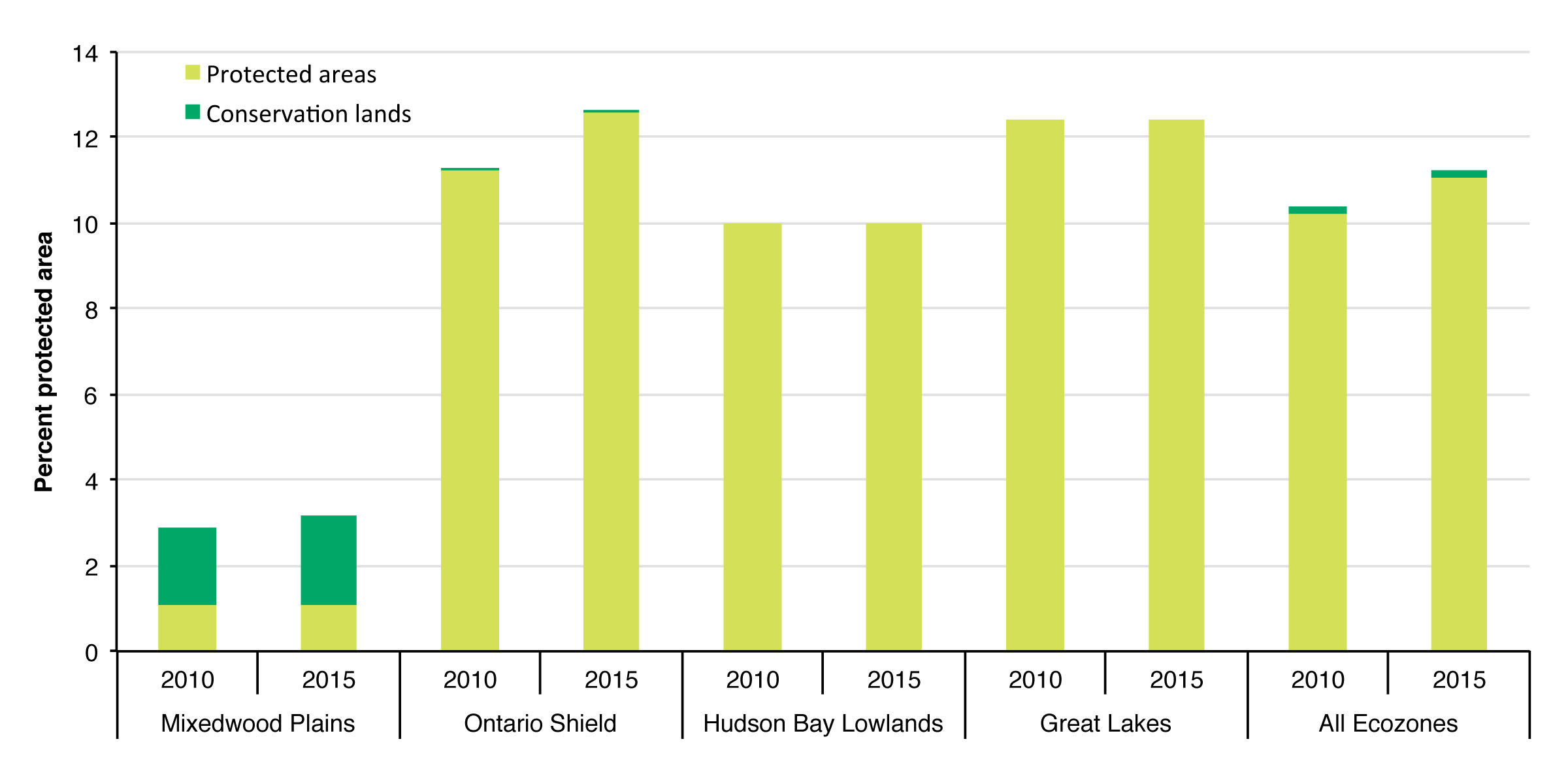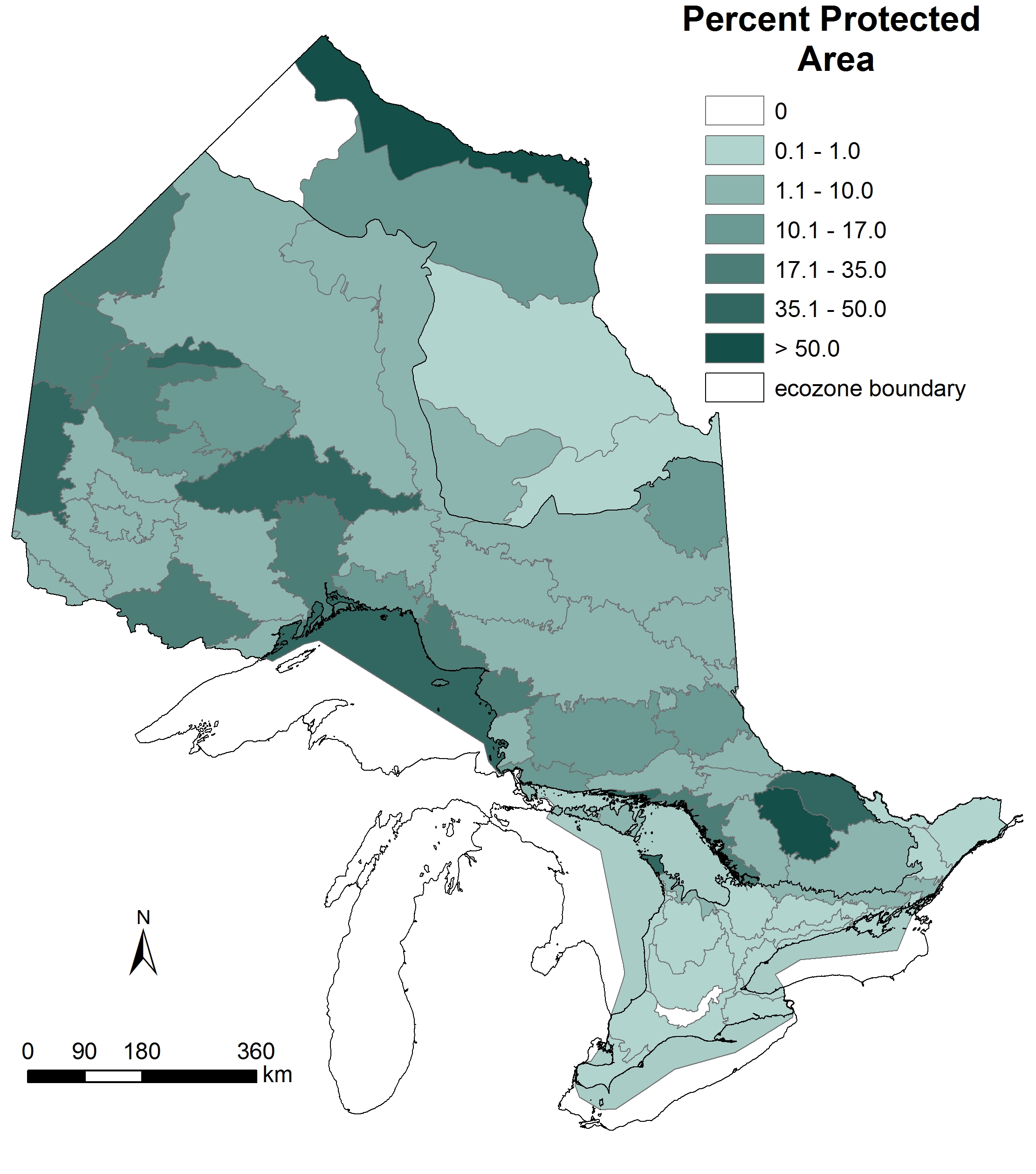This indicator assesses trends in the percentage of regulated protected areas, Dedicated Protected Areas in the Far North and conservation lands within Ontario by ecozone.

Figure 1. Percentage of Ontario’s ecozones that consist of protected areas (including Dedicated Protected Areas in the Far North) and conservation lands.
Figure 1. Percentage of Ontario’s ecozones that consist of protected areas (including Dedicated Protected Areas in the Far North) and conservation lands.

Figure 2. Percentage of each ecodistrict that consists of protected areas (including Dedicated Protected Areas in the Far North).
Figure 2. Percentage of each ecodistrict that consists of protected areas (including Dedicated Protected Areas in the Far North).
Status:
- 11.1% of Ontario is protected within provincial and national parks, Dedicated Protected Areas (DPAs) in the Far North, conservation reserves and wilderness areas. A further 0.2% is protected by conservation lands.
- The proportion of ecozone area in protected areas and conservation lands is highest in the Ontario Shield Ecozone (12.6%), followed by the Great Lakes Ecozone (12.4%), Hudson Bay Lowlands Ecozone (10.0%), and the Mixedwood Plains Ecozone (3.1%). The Lake Superior National Marine Conservation Area accounts for 99% of the protected area in the Great Lakes Ecozone.
- Since 2010, there has been an increase in protected areas in the Ontario Shield Ecozone, largely associated with the establishment of DPAs in the Far North. There has also been an increase in the area of conservation lands in the Mixedwood Plains Ecozone.
- While the proportion of the province conserved in protected areas and conservation lands has increased from 10.4% to 11.2% since 2010, it is still well short of the 17% target.
Data on the area and location of regulated protected areas were downloaded from the Conservation Areas Reporting and Tracking System (CARTS). Data on Far North DPAs is contained in (as of December, 2014) four approved community based land use plans (OMNRF 2014). Information on conservation lands and conservation easements was obtained from various conservation organizations (Conservation Ontario, Ducks Unlimited Canada, Nature Conservancy Canada, Ontario Heritage Trust and Ontario Land Trust Alliance). Lands and easements held by these organizations (excluding cultural and built-up areas) were considered to qualify as other effective area-based conservation measures for the purpose of this indicator. The Canadian Council on Ecological Areas is currently developing guidance to identify eligible conservation lands (CCEA 2013). Lands for which there are term-limited conservation agreements that were included in this indicator in 2010 have not been included in this update consistent with interim guidance from the Canadian Council on Ecological Areas (CCEA 2013).
The percentage of protected areas, DPAs and conservation lands was calculated for each ecozone (three terrestrial ecozones plus the waters of the Great Lakes Ecozone) and compared to 2010 values (Figure 1). Spatial data were also used to map the proportion of each terrestrial ecodistrict that consists of regulated protected areas and DPAs (Figure 2). Comprehensive spatial data are currently not available for conservation lands
Web Links:
Ontario Parks http://www.ontario.ca/environment-and-energy/provincial-parks-and-conservation-reserves-planning
Ontario Far North land Use Planning Initiative http://www.ontario.ca/rural-and-north/far-north-land-use-planning-initiative
Parks Canada http://www.pc.gc.ca/progs/np-pn/pr-sp/index_e.asp
Conservation Ontario http://www.conservation-ontario.on.ca/
Ducks Unlimited Canada http://www.ducks.ca/
Nature Conservancy Canada http://www.natureconservancy.ca/
Ontario Heritage Trust http://www.heritagetrust.on.ca/
Ontario Land Trust Alliance http://olta.ca/
References:
Convention on Biological Diversity (CBD). 2010. The strategic plan for biodiversity 2011-2020 and the Aichi biodiversity targets. [Available at: http://www.cbd.int/doc/decisions/COP-10/cop-10-dec-02-en.pdf]
Canadian Council on Ecological Areas (CCEA). 2013. Interpreting Aichi biodiversity target 11 in the Canadian context: towards consensus on “other effective area-based conservation measures”, October 2013. Canadian Council on Ecological Areas, Ottawa, ON. [Available at: http://www.ccea.org/aichi-target-11-workshop-report/]
Canadian Council on Ecological Areas (CCEA). 2014. Conservation Areas Reporting and Tracking System (CARTS). [Available at: http://www.ccea.org/tools-resources/carts/, accessed on August 25, 2014]
Ontario Biodiversity Council. 2011. Ontario’s biodiversity strategy, 2011: renewing our commitment to protecting what sustains us. Ontario Biodiversity Council, Peterborough, ON.
Ontario Ministry of Natural Resources and Forestry (OMNRF). 2014. Dedicated Protected Areas in the Far North of Ontario. Ontario Ministry of Natural Resources and Forestry, Peterborough, ON.


